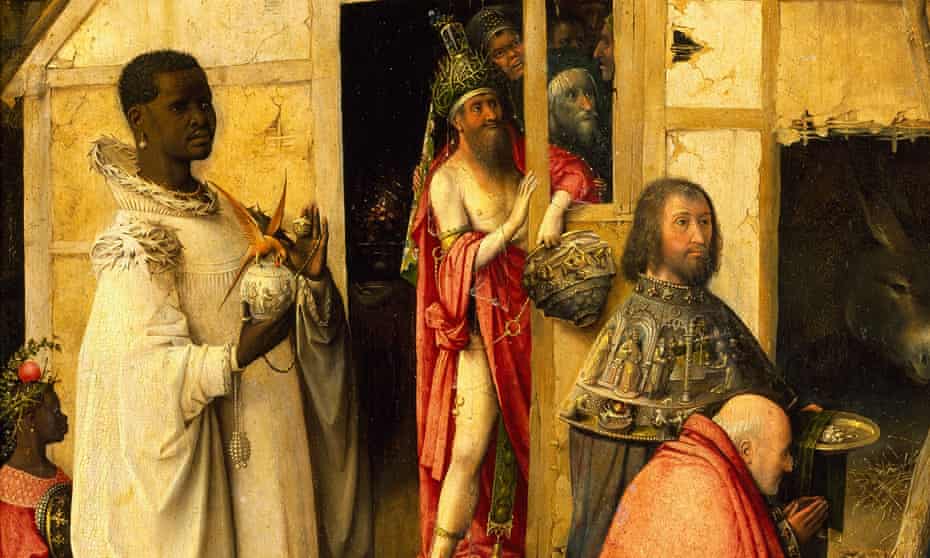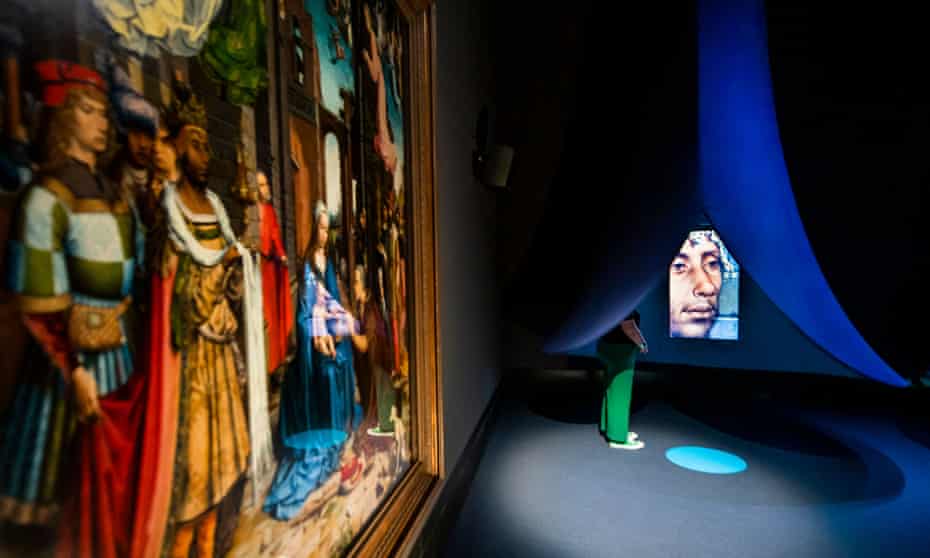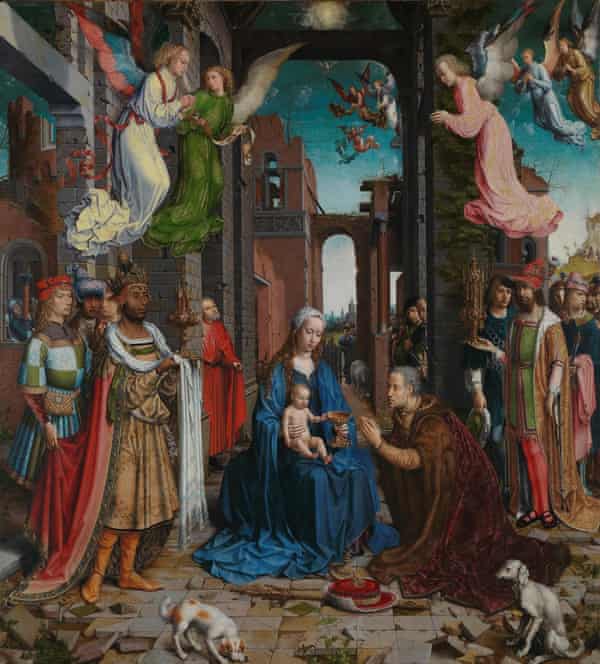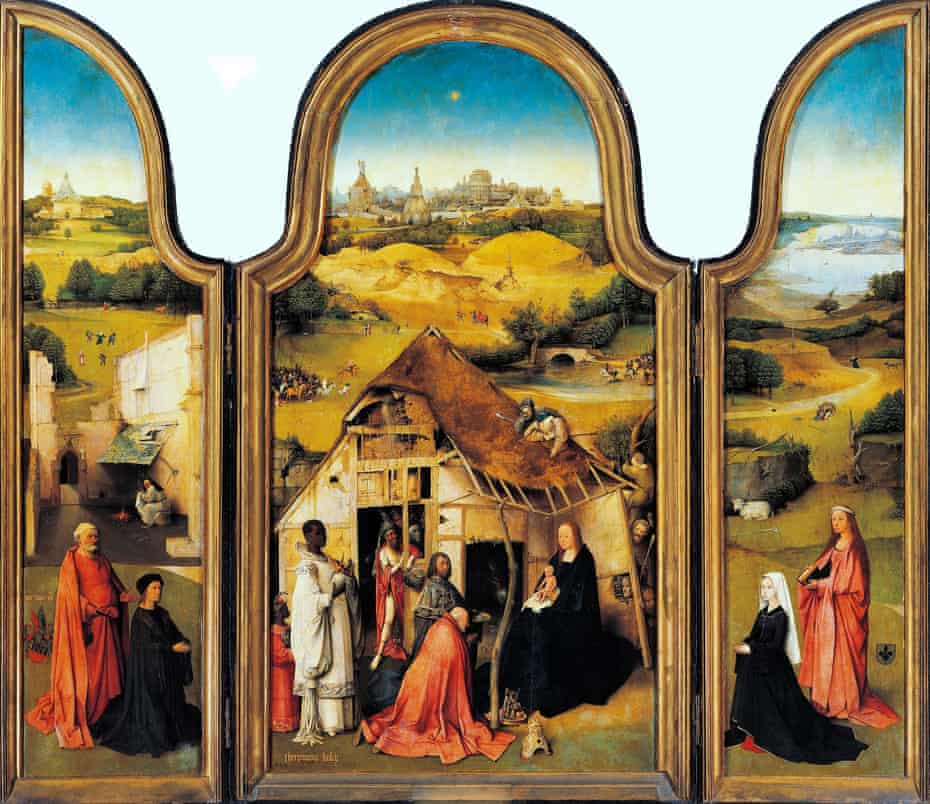Myrrh mystery: how did Balthasar, one of the three kings, become black?
December 21, 2020
They came bearing gifts of gold, frankincense and myrrh. This description of the Magi, the three kings or wise men who followed a star to the newborn Jesus, has always given artists plenty of scope to depict ornate boxes, cups and vessels. Paintings show them followed by pages, servants, soldiers and pack animals – an entire royal retinue. Dressed in their finest, making their way across deserts and over mountains guided by a light, these pilgrims to the lowly stable always look magnificent.
Although the Gospel of Matthew does not give individual names to this regal trio, we know them as Balthasar, Caspar and Melchior, thanks to a Greek manuscript from AD500. It was in the middle ages, too, that they were promoted from astronomers to kings. And a text attributed to the Venerable Bede, the historian monk from Northumbria, makes Balthasar black. Despite Bede’s assertion, there are very few images of a black Balthasar before 1400, possibly because medieval Europeans had so little concept of Africans. It was only with the dawning of the Renaissance that Balthasar’s colour began to be emphatically depicted. In fact, the trumpeting, joyous festive subject of “the adoration” inspired some of the richest portrayals of black people in European art.
You can get a taste of this in Sensing the Unseen, the Christmas exhibition of the National Gallery in London, which creates an entire soundscape to enhance The Adoration of the Kings, the wonderfully detailed painting by Jan Gossaert of the Low Countries. Amid the lowing of oxen and the ringing of bells, Balthasar speaks: a poem by the British-Nigerian writer Theresa Lola gives a voice to this black king, a stranger in a strange land. Lola imagines him dwelling on how different, how self-conscious he feels. “The ground seems to be opening its teeth, either to bite or to kiss me – my eyes feel foreign. I guess to know deeply, one must look deeply.”

Our attention is directed to the pensive eyes and melancholy face of Balthasar in Gossaert’s scene, painted at the start of the 16th century. At times, though, all these aural additions are as much distraction as enhancement: you look at screens instead of the work, amid a digital environment that’s not quite vivid enough, certainly not as vivid as the painting. Yet this celebration of Balthasar highlights something new and revolutionary that happened in Renaissance art, something that still makes the black magus haunting today, as his image appears on millions of Christmas cards sent around the world, with few people aware of how groundbreaking the picture they just sealed into an envelope was.
Artists in 15th- and 16th-century Europe essentially invented the image of Balthasar the black king. The emergence of a realistically portrayed black character in Renaissance art reflected not Bede’s long-ignored claim, but the growing visibility of other races in a Europe that previously had little concept of elsewhere. This was due to a seismic shift in global events as European ships, led by Portugal and Spain, explored the Atlantic and established trading – and slaving – outposts on the African coast. Behind those dark daubs of paint lay a new curiosity about people and about peoples: the “humanist” thinking of the Renaissance that inspired the great French philosopher Montaigne to declare that all global customs and beliefs are equally valid. It also inspired Shakespeare put a black hero on stage in Othello.
In Albrecht Dürer’s Adoration of the Magi, painted in the artist’s home city of Nuremberg in 1504, a young black man with short hair and red leggings stands elegantly, holding a spherical gold goblet full of myrrh, a natural aromatic. The next king along is turning to look at his gift – or perhaps his legs. This causes an intriguing frisson as the long-haired magus caught in mid-turn is a self-portrait of the bisexual Dürer himself.

What’s especially intriguing is that these depictions of a black Balthasar were a choice: they were neither obligatory nor universal in Renaissance art. In Florence, for example, the black magus was whitewashed. All the kings in Botticelli’s famous 1475 adoration are white (as they are in Benozzo Gozzoli’s Procession of the Magi). That’s because they are actually portraits of the Medici family, who liked to identify with these wise and magnificent monarchs.
The north Italian artist Andrea Mantegna also painted adorations that make Balthasar an African. In one intimate work, we see a porcelain cup – a gift that would have come all the way from from China. The reason for its inclusion, which can only be anachronistic, echoes Mantegna’s decision to make Balthasar black: the artist seems to be drawing from the world around him. Mantegna married into the artistic Bellini family of Venice, the kind of bustling maritime city where you might find a Chinese cup and – as the story of Othello dramatises – meet black people.
Black Balthasars in Renaissance art are often connected with such cosmopolitan seaports. Gossaert is a good example. He probably started his career in Antwerp, one of Europe’s busiest ports and a place where you would encounter Africans. In 1521, Dürer visited the port and drew a touchingly immediate portrait of Katharina, a black servant in the household of the Portuguese merchant João Brandão. Dürer’s journal recounts his friendly dealings with Portuguese traders who gave him exotic gifts.

In Hieronymus Bosch’s delirious, hypnotic Adoration of the Magi, painted for an Antwerp couple in the 1490s, Joseph washes Jesus’s nappy as mysterious crowds swarm towards the stable, where the Antichrist looks on malevolently. There’s no denying the splendour of Bosch’s Balthasar. Contrasting vividly with his complexion, the fantastical white robe the magus wears is a surreal delight, spilling on to the ground with a creamy yet solid appearance, full of ornate leafy details that look more carved than sewn. It could be one of the ivory artworks Portuguese ships brought from west Africa. Bosch’s Balthasar, you could almost say, is wearing African art.
If that seems a stretch, it’s no one-off. There’s an adoration by Bosch’s disciple Pieter Bruegel the Elder that also gives Balthasar an ivory-coloured gown. And his gift is a gold vessel in the shape of a sailing ship, an explicit image of the Atlantic trade in gold and human beings. Bosch painted his adoration in the decade Columbus made landfall in the New World. Its intimations of a strange new earth, with the star shining over an astonishingly futuristic city, mirror his masterpiece, The Garden of Earthly Delights. Bosch’s adoration is a hallucinatory intimation of a world reborn, where the slaves he may have seen in Antwerp have transformed into a magnificent king and his page.

Dürer gives his black king the contrapposto pose of a classical statue and, through the self-portrait, seems to be giving the pilgrim king the same kind of look he gave men on a trip to Venice, where he wrote about the sexy soldiers. His adoration seems to confess to desires that cross boundaries. The artist wrote of “the subtle ingenuity of people in foreign lands” and the gifts his Balthasar brings seem like an expression of this admiration.
You certainly can’t accuse Dürer, Bosch or Bruegel of painting an all-white world. Bruegel’s magnificent Adoration of the Magi in the Snow brings the kings from afar right into an archetypal European village, shivering in a white Christmas. Snowflakes spatter the surface of the picture – not just the first time they were represented, but also one of the most radical instances, as Bruegel flirts with something like abstraction in his depiction of a monochrome wonderland.
It looks like a Christmas card drunk on Trappist beer, the festive season taken to magical extremes. Sloping rooftops are white. The ground is white. But not all the people are white. As WH Auden wrote in his poem Musee des Beaux Arts, the old master Bruegel makes every incident, however tumultuous, part of a much wider canvas full of everyday, unremarkable events. Here he shunts the adoration, supposedly the main action, way off to the left and even keeps it partially concealed. Three foreign kings? The birth of the Messiah? It’s just part of village life, with Balthasar just part of the European scene, his presence accepted and little noticed.
• Sensing the Unseen is scheduled for 6 January to 28 February at the National Gallery, London. The gallery is closed due to Covid-19, but the exhibition will be available online.
$0
No comments:
Post a Comment